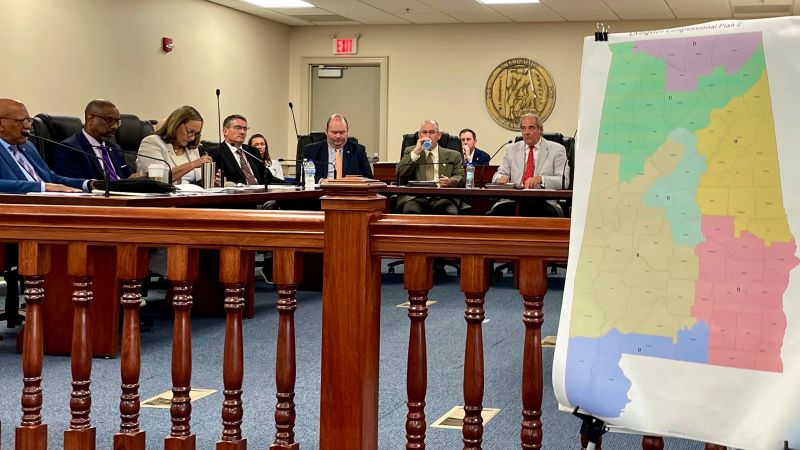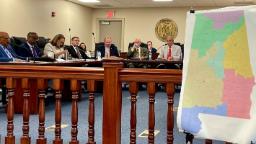

A version of this story appeared in CNN’s What Matters newsletter. To get it in your inbox, sign up for free here.
CNN
—
It was a legitimate surprise when the conservative-dominated US Supreme Court ordered Alabama’s conservative-dominated state government last month to redraw its congressional map and include either a second majority-Black congressional district or something quite close to it.
It may be equally surprising that Alabama appears to have said no.
Instead of simply complying with the Supreme Court’s order in the Allen v. Milligan case, Alabama’s legislature redrew the congressional map to lower the Black voting-age population in the existing Democratic seat held by Rep. Terri Sewell from about 55% to just over 50% and then increased a second district’s Black population percentage to about 40%.
The new map approved by Alabama’s legislature and governor will go before federal courts for review in August, so this story is far from over.
And it will combine with fights over congressional maps in other states, especially New York, in such a way that control of the House could very much be at stake.
Alabama Gov. Kay Ivey, a Republican, seemed to defend the legislature’s insolence in the face of the federal courts’ orders when it approved the new map Friday.
“The Legislature knows our state, our people and our districts better than the federal courts or activist groups,” she said in a statement.
CNN’s Dianne Gallagher noted in her report that the old congressional map was invalidated by a three-judge federal district court panel that included two judges nominated to the bench by former President Donald Trump.
They concluded the plan by which Alabamians selected their congressional delegation in 2022 likely violated the Voting Rights Act because Black voters have “less opportunity than other Alabamians to elect candidates of their choice to Congress.”
Before the 2022 midterm election, the US Supreme Court had tabled action on Alabama’s map, which helped Republicans win the barely there four-seat House majority they currently hold.
Gallagher and CNN’s Tierney Sneed wrote last month that the Allen v. Milligan decision could have consequences for other states and reignite a series of lawsuits in multiple states.
“Outright defiance of the Supreme Court’s order,” is how Janai Nelson, president of the NAACP Legal Defense Fund, described the new map to CNN’s Dana Bash Monday.
“In this moment, it is up to our federal courts to protect Black voters and also to protect their own authority here,” she later added.
The background here is that Alabama’s population is about 27% Black, but the Black population in the state is focused on a number of counties that are overwhelmingly African American – an area known as the state’s Black Belt, although it is named for the area’s fertile soil. The interest of giving the voters of the Black Belt, many of whom are Black, representation in Congress, is all over the Supreme Court’s decision.
Coincidentally, earlier this year, President Joe Biden named Alabama’s Black Belt, site of many key moments in the Civil Rights Movement, as a National Heritage Area.
To Nelson, the math suggests that since Black Alabamians represent about a quarter of the state’s population, they should get representation from more than one of the seven lawmakers representing Alabama in Congress.
But the issue is larger than simple math since Alabama, both historically and currently, is marked by polarized voting conditions.
“This is a mandate by civil rights laws to make sure that there’s fairness in our systems, that Black voters and other voters who have been historically discriminated against have an opportunity to have representatives who will speak to their interests and give voice to their concerns,” she said.
Alabama had asked the Supreme Court to essentially nullify Section 2 of the Voting Rights Act, something many court watchers thought the conservative majority was primed to execute.
But Chief Justice John Roberts and Justice Brett Kavanaugh joined liberals on the court to throw out the Alabama map.
The Supreme Court also rejected out of hand the idea that the Gulf Coast area represents a community of interest on par with the Black Belt. The new map, according to the state attorney general’s office, still tries to keep the Gulf Coast community together in a single district.
In a statement, the attorney general’s office argued the new map is fair and complies with the principles of the Voting Rights Act and seeks to unite the Black Belt counties.
The other political story here is that, like most congressional districts nationwide, not one of the districts in which Alabamians voted in the 2022 midterm elections was even relatively competitive. The only winning candidate who got less than two-thirds of the vote was the Democrat, Sewell. And she still got more than 63% of the heavily Democratic district.
